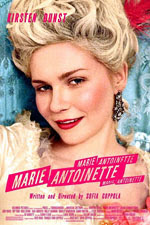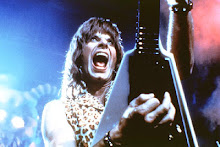Let Them Eat Cake
Let them do anything except watch the abysmal film "Marie Antoinette." For those few people who saw Sofia Coppola's "Marie Antoinette," I am sadly too late. For everyone else, take heed: "Marie Antoinette" takes a guillotine to the filmmaking process.
Most people know the basics of Marie Antoinettte's story: Austrian Archdutchess, married at a very young age to the future King Louis XVI of France, installed and isolated at the insanely opulent Versailles palace, out of touch while the French Revolution takes place all around her to the point of making her famously callous remark "let them eat cake" when told that her countrymen had no bread to eat, and, finally, paying for this callousness with her life. This is a terrific story that would make a great film. All the filmmaker needs to do is follow the plot that already exists.
Astoundingly, Sofia Coppola, who wrote, produced and directed "Marie Antoinette," ignored much of the history that was right in front of her. While would-be screenwriters are repeatedly told that every scene in their films must drive the plot forward, "Marie Antoinette" has no plot at all. Rather, it's a lavish series of set pieces taking place at Versailles, with fabulous (and Oscar-winning) costumes, opulent displays of food, giggly shopping sprees with the Queen and her girlfriends, designer shoes and wigs, masked balls, and sexual intrigue. "Marie Antoinette" is a gallery full of very pretty paintings. Unfortunately, still-life paintings do not make a movie.
Perhaps Sofia Coppola's motive was to leave out the plot and concentrate on shallow, pretty images precisely to show how shallow Marie Antoinette's life was at Versailles. Somehow, I doubt it. Some of Coppola's best-known and best-liked films, such as The Virgin Suicides and Lost in Translation, are full of gorgeous imagery but lack much of a plot as well. I guess when one is a member of the most nepotistic family in film history ("Marie Antoinette" also co-stars Coppola's first cousin Jason Schwartzman), one can violate many rules that apply to the rest of us.
But alas, even a Coppola cannot violate the harsh rule of supply and demand that exists at the movie box office.
Most people know the basics of Marie Antoinettte's story: Austrian Archdutchess, married at a very young age to the future King Louis XVI of France, installed and isolated at the insanely opulent Versailles palace, out of touch while the French Revolution takes place all around her to the point of making her famously callous remark "let them eat cake" when told that her countrymen had no bread to eat, and, finally, paying for this callousness with her life. This is a terrific story that would make a great film. All the filmmaker needs to do is follow the plot that already exists.
Astoundingly, Sofia Coppola, who wrote, produced and directed "Marie Antoinette," ignored much of the history that was right in front of her. While would-be screenwriters are repeatedly told that every scene in their films must drive the plot forward, "Marie Antoinette" has no plot at all. Rather, it's a lavish series of set pieces taking place at Versailles, with fabulous (and Oscar-winning) costumes, opulent displays of food, giggly shopping sprees with the Queen and her girlfriends, designer shoes and wigs, masked balls, and sexual intrigue. "Marie Antoinette" is a gallery full of very pretty paintings. Unfortunately, still-life paintings do not make a movie.
Perhaps Sofia Coppola's motive was to leave out the plot and concentrate on shallow, pretty images precisely to show how shallow Marie Antoinette's life was at Versailles. Somehow, I doubt it. Some of Coppola's best-known and best-liked films, such as The Virgin Suicides and Lost in Translation, are full of gorgeous imagery but lack much of a plot as well. I guess when one is a member of the most nepotistic family in film history ("Marie Antoinette" also co-stars Coppola's first cousin Jason Schwartzman), one can violate many rules that apply to the rest of us.
But alas, even a Coppola cannot violate the harsh rule of supply and demand that exists at the movie box office.





4 Comments:
I liked the movie...(though granted it wasn't unforgettable Oscar-level or anything) - thought it was creative, different, interestingly art-directed. But have talked to just as many who disliked it as you did. Yet everyone I met who liked Marie Antoinette was female, so maybe it's a chick thing (similar to how appreciating Rush/Geddy Lee seems exclusively linked to the male chromosome)
It must have been the shoes and the wigs. So you don't like Rush? Next you'll tell me you don't like the Three Stooges!
Too bad Jake couldn't have added some spunk to this film. They did wear those big collars in Marie Antoinette's France, yes?
What a waste of a good story and a lot of money.
Are you writing any screenplays these days?
I'm not currently writing screenplays, but there must be opportunities for those willing to cross the WGA picket line. Hmm, costume drama starring Jake....
Post a Comment
<< Home